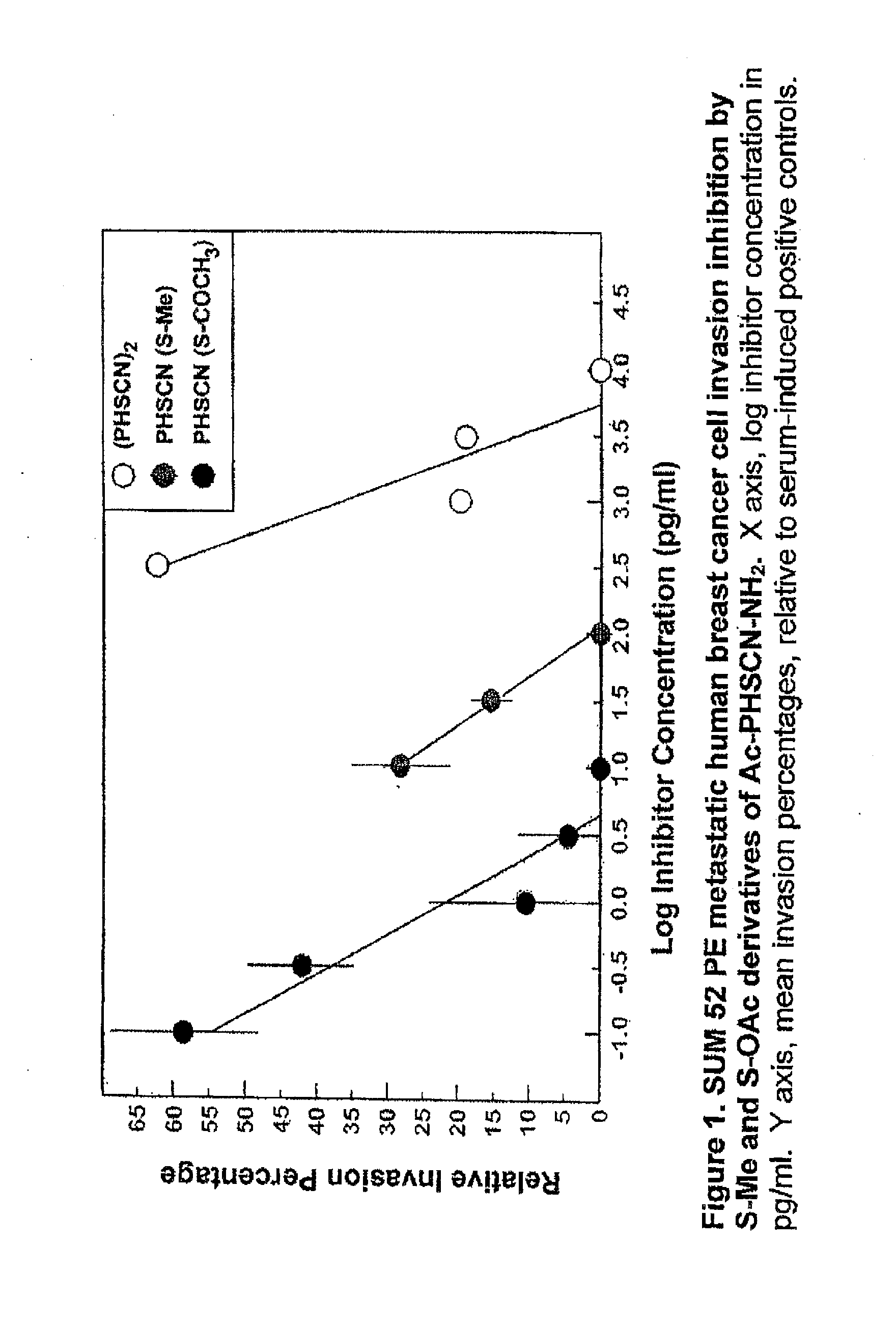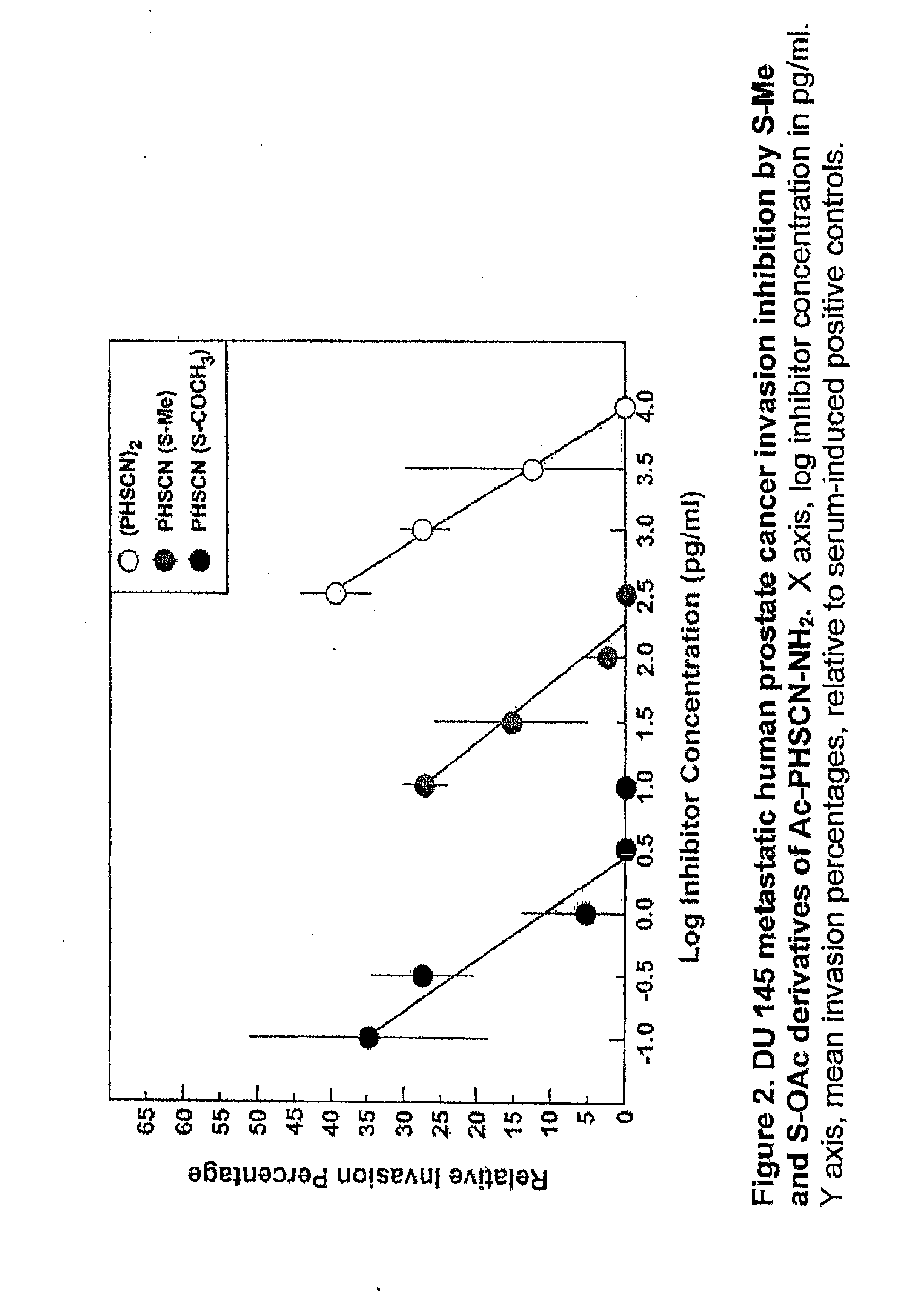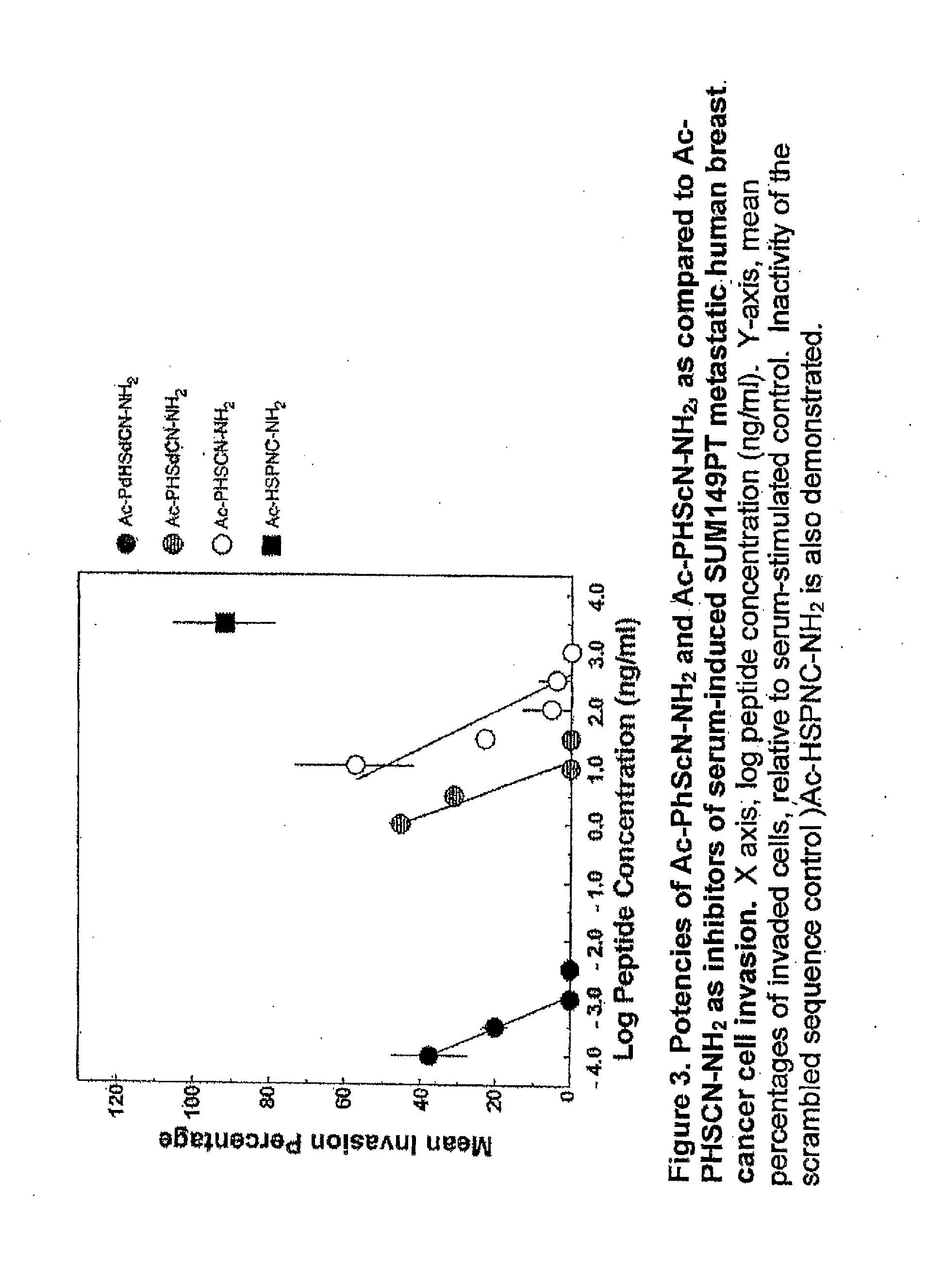Compounds For, and Methods of, Treating Cancer and Inhibiting Invasion and Metastases
a technology of cancer and compounds, applied in the field of cancer treatment, can solve the problems of affecting the success of chemotherapeutics as anticancer agents, affecting the success of particular cancer treatments, and usually not being practical in the majority of cases, so as to inhibit the ability, inhibit the invasion and metastases, and enhance the effect of radiation on cancer
- Summary
- Abstract
- Description
- Claims
- Application Information
AI Technical Summary
Benefits of technology
Problems solved by technology
Method used
Image
Examples
example 1
[0062]In this example, PHSCN peptides, where the sulfur of the SH group of cysteine was modified to block disulfide bond formation, were tested in an in vitro invasion assay utilizing naturally occurring basement membranes. More specifically, the invasion-inhibiting potencies of S-methylated and S-acetylated derivatives of the PHSCN (SEQ ID NO:1) peptide [i.e. Ac-PHSC(S—CH3)N—NH2 (SEQ ID NO:3) and Ac-PHSC(S—COCH3)N—NH2, (SEQ ID NO:4), respectively] were quantitated [in comparison with PHSCN (SEQ ID NO:1) dimerized by S—S bond formation] with two types of metastatic human cancer cell lines, i.e. a breast cell line (SUM 52 PE) and a prostate cell line (DU 145) (see FIG. 1 and FIG. 2, respectively). These modified peptides prevent breast cancer and prostate cancer invasion at concentrations in the pg / ml range. The S-methylated variant appears to be 1000-fold more potent, and S-acetylated variant appears to be 100,000-fold more potent, than the unmodified PHSCN (SEQ ID NO:1).
example 2
[0063]In this example, PHSCN peptides, where two L-amino acids are substituted with D-amino acids, were tested in an in vitro invasion assay utilizing naturally occurring basement membranes. More specifically, the invasion-inhibiting potencies of Ac-PHScN—NH2 (SEQ ID NO:7), and Ac-PhScN—NH2 (SEQ ID NO:8) were quantitated [in comparison with Ac-PHSCN—NH2 (SEQ ID NO:12) as well as a scrambled peptide Ac-HSPNC—NH2 (SEQ ID NO:15)] with two types of metastatic human cancer cell lines, i.e. a breast cell line (SUM 52 PE) and a prostate cell line (DU 145) (see FIG. 3 and FIG. 4, respectively), as well as human microvascular cells (“hmvec”) (see FIG. 5). These modified peptides prevent breast cancer and prostate cancer invasion at concentrations in the pg / ml range. Indeed, the peptide comprising two D-amino acids, Ac-PhScN—NH2 (SEQ ID NO:8), demonstrated inhibition in the range of 3 to 10 pg / ml (5.0 to 16.7 pM). The peptide comprising only one D-amino acid was also better than the controls,...
example 3
[0065]In this example, PHSCN peptides, where two L-amino acids are substituted with D-amino acids, were tested in vivo. FIG. 6 compares the antitumorigenic effects of systemic Ac-PhScN—NH2 (SEQ ID NO:8) therapy at three different dosages (0.5, 0.05, and 0.005 micrograms per kg) with the antitumorigenic effects of 0.5 mg (500 micrograms) per kg of Ac-PHSCN—NH2 (SEQ ID NO:12) therapy using the DU 145 prostate cancer (as well as with untreated controls). The experiment involved generating subcutaneous DU 145 tumors in nude mice. More specifically, 500,000 suspended DU 145 cells were injected subcutaneously into the flanks of athymic nude mice. All mice were allowed to grow untreated DU 145 tumors in their flanks for about 8 weeks. All 3 therapies (i.e. using the three different dosages) were administered thrice-weekly by tail vein injection after the tumors became palpable. Each treatment group consisted of 8 intramuscular (flank) tumors. After 7 weeks of treatment, when the untreated ...
PUM
| Property | Measurement | Unit |
|---|---|---|
| concentration | aaaaa | aaaaa |
| time | aaaaa | aaaaa |
| pH | aaaaa | aaaaa |
Abstract
Description
Claims
Application Information
 Login to View More
Login to View More - R&D
- Intellectual Property
- Life Sciences
- Materials
- Tech Scout
- Unparalleled Data Quality
- Higher Quality Content
- 60% Fewer Hallucinations
Browse by: Latest US Patents, China's latest patents, Technical Efficacy Thesaurus, Application Domain, Technology Topic, Popular Technical Reports.
© 2025 PatSnap. All rights reserved.Legal|Privacy policy|Modern Slavery Act Transparency Statement|Sitemap|About US| Contact US: help@patsnap.com



